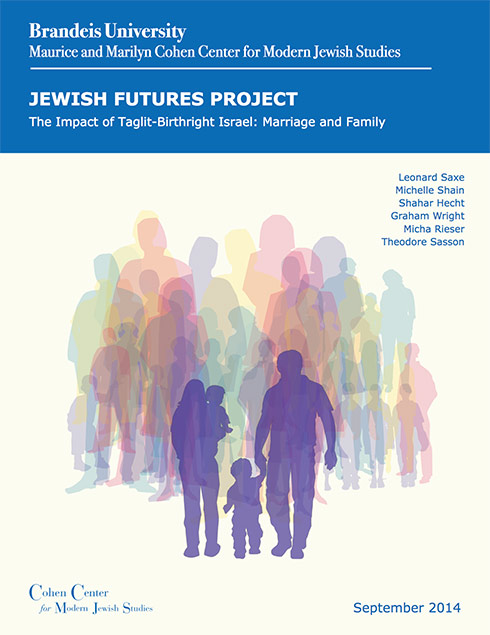Jewish Futures Project. The Impact of Taglit-Birthright Israel: Marriage and Family
Leonard Saxe, Michelle Shain, Shahar Hecht, Graham Wright, Micha Rieser and Theodore Sasson
September 2014
 This report examines Taglit’s long-term impact on participants with a special focus on their decisions about marriage and children. The findings are from data collected in 2013 for the fourth wave of the “Jewish Futures Project” (JFP), a panel study of individuals who applied to Taglit between 2001 and 2006.
This report examines Taglit’s long-term impact on participants with a special focus on their decisions about marriage and children. The findings are from data collected in 2013 for the fourth wave of the “Jewish Futures Project” (JFP), a panel study of individuals who applied to Taglit between 2001 and 2006.
Interviews, both telephone and web, were conducted with over 2,000 respondents. The analysis compares Taglit participants to those who applied to the program but did not participate.
The JFP panelists are now old enough (25-40 years old) to focus on the ways in which Taglit impacts decisions abount marriage and family. The findings examine differences between the children of inmarriage and the children of intermarriage and the ways in which inmarriage relates to engagement in Jewish life.
Key Findings
-
As of 2013, 45 percent of JFP panelists are married and another 15 percent are living with a significant other. Among those who are currently married, Taglit participants are much more likely than nonparticipants to be married to a Jew. Overall, the likelihood of inmarriage for participants is 72 percent, while for nonparticipants, the likelihood is 51 percent. This finding is consistent with previous waves of the study.
-
Particularly striking is that among participants whose parents are intermarried, the probability of inmarriage is 55 percent, compared to 22 percent for those nonparticipants who are children of intermarried parents. For participants whose parents are inmarried, the probability of inmarriage is 75 percent, compared to 60 percent for nonparticipants.
-
Overall, just under 30 percent of JFP panelists have at least one child. Parents who are married to Jews are more likely to raise children Jewish. In addition, they are more likely to have a brit milah (Jewish ritual circumcision) or Jewish naming ceremony for their children, celebrate Shabbat and Jewish holidays, be members of a synagogue and attend religious services, send their children to Jewish day care or preschool, and participate in the PJ library. Because Taglit increases the likelihood of marrying a Jew, participation in the program leads to higher levels of engagement.
-
Taglit has a number of other effects, beyond its impact on marriage choices. Even among those who are unmarried, or who are married to a non-Jew, Taglit participants are more likely to celebrate Shabbat and Jewish holidays, have Jewish friends, belong to a synagogue and attend religious services.